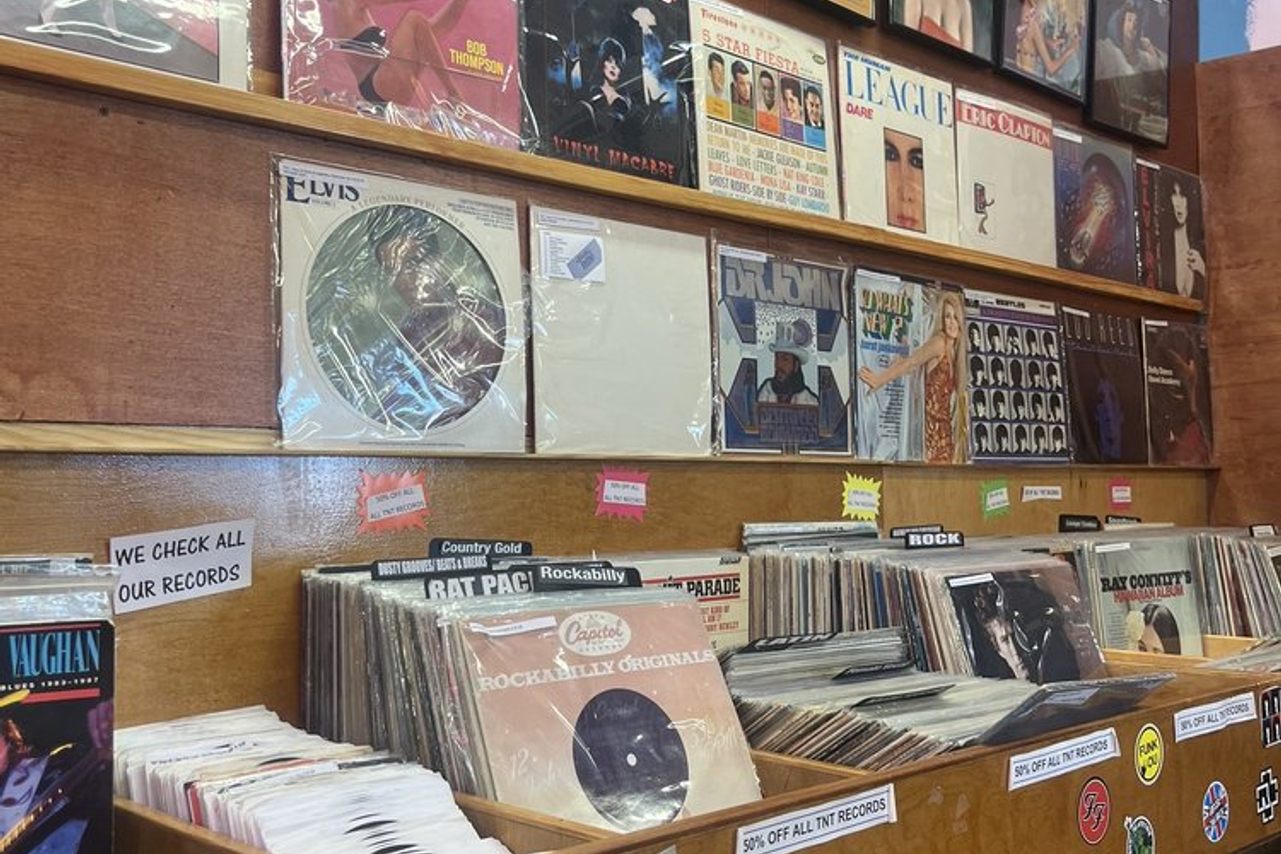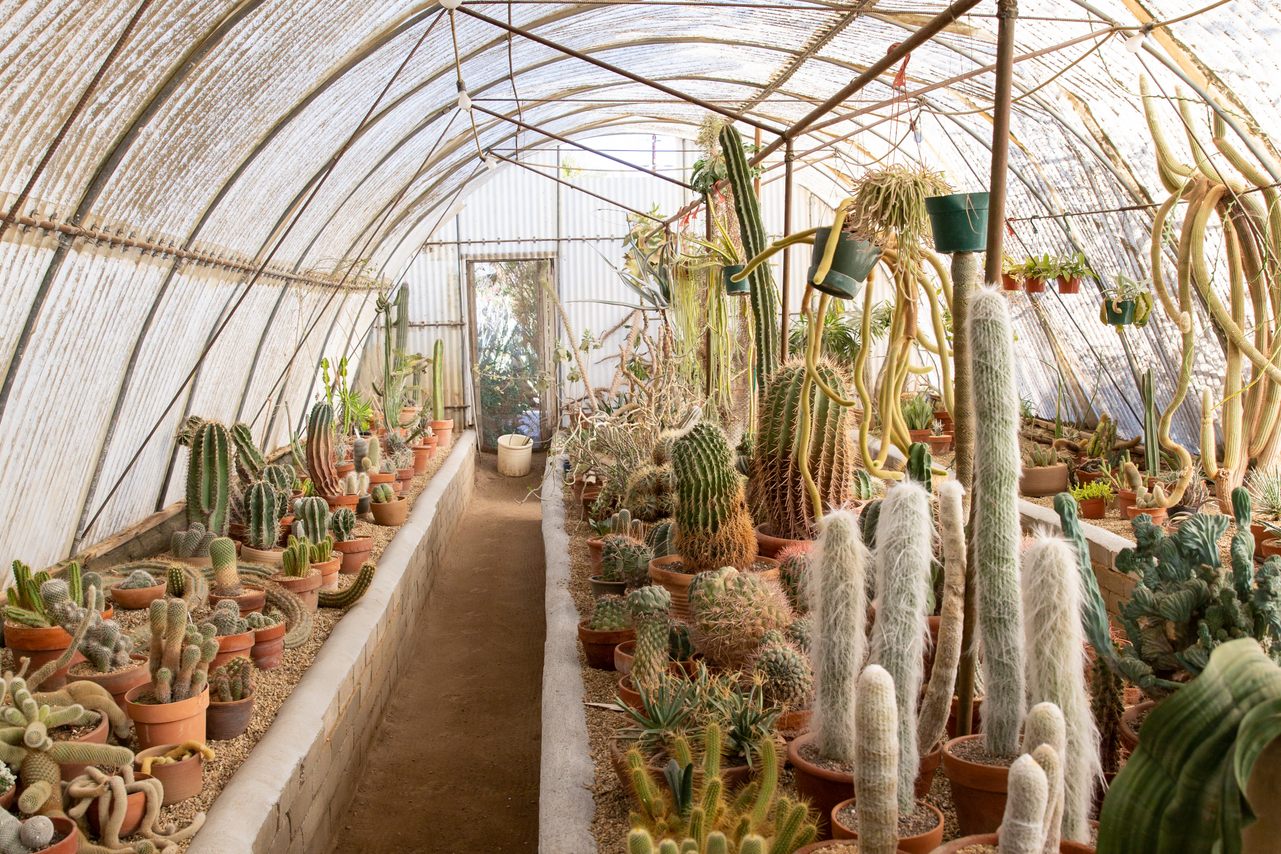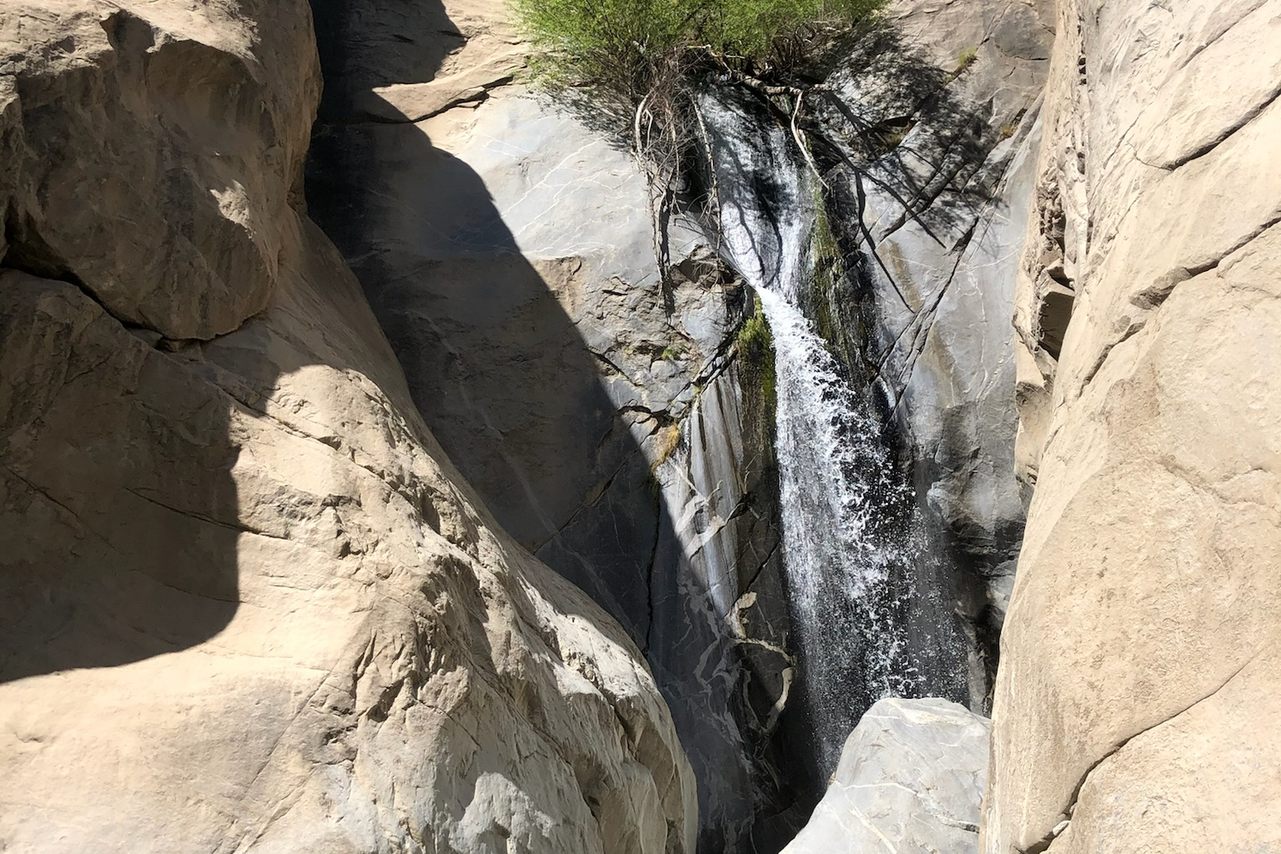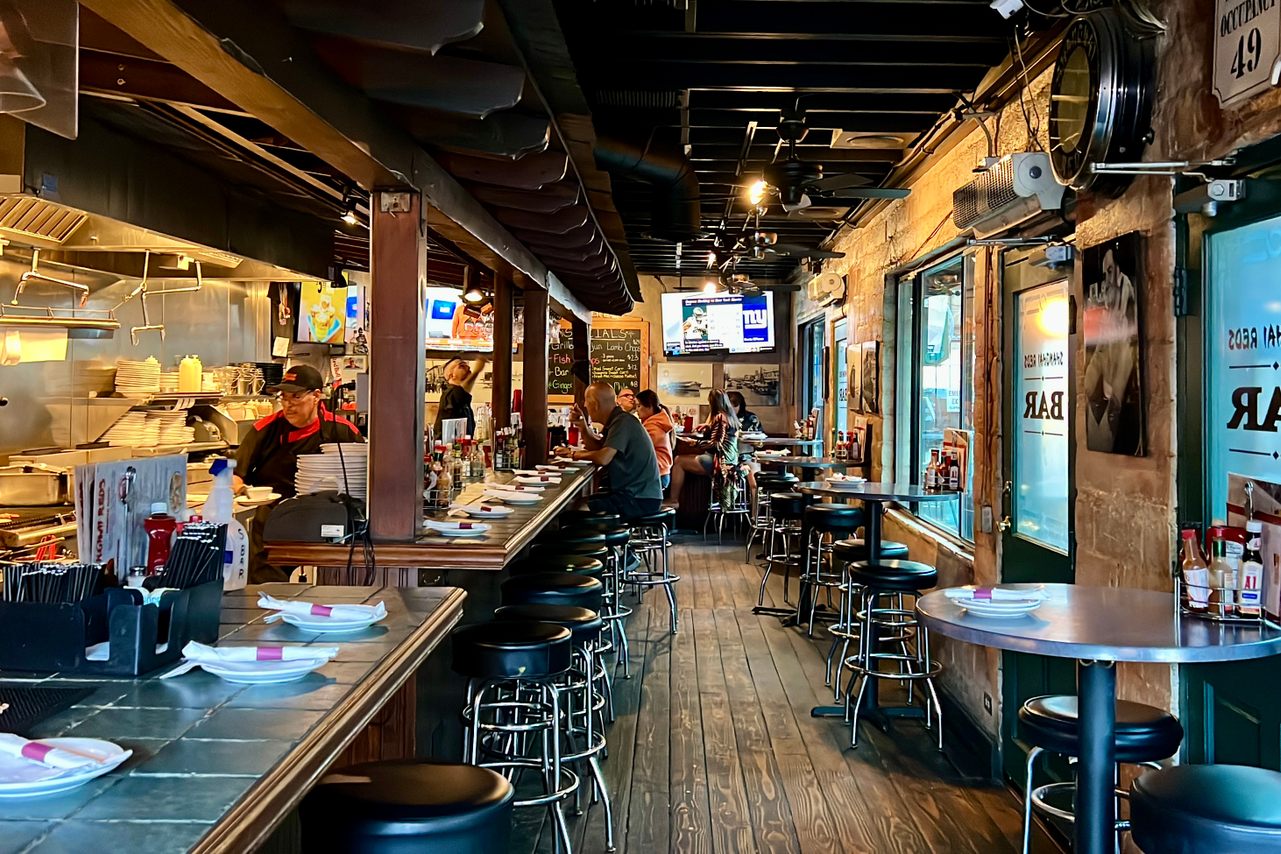
1. Sunny Dunes Antique Mall
Palm Springs is known for its vintage shopping, and if you want to get serious about it, you’d be well served starting at Sunny Dunes Antique Mall. The place is massive and there’s no telling what treasures you’ll find as you wander around the 6,000-square-foot warehouse. Forty-plus antique dealers sling goods as diverse as art and jewelry to postcards and dolls. A recent teaser on Instagram showed colored glassware, an electric guitar, and a cute but horrifying frog-shaped cookie jar. You’ll definitely come away with a Palm Springs souvenir—or, if you really fall in love, some midcentury modern furnishings to fill your home.
507 E Sunny Dunes Rd, Palm Springs, CA 92264

2. RoboLights
What seems at first glance like a sleepy neighborhood hides one of the great oddities of Palm Springs: a private sculpture garden of huge, colorful robots, all built out of garbage by one man.
Kenny Irwin, Jr., has been building sci-fi-inspired art in his front yard since he was 9 years old. Encouraged by his father, he lit up his creations every year for a massive holiday spectacle. As the years went on, the robots were joined by Santa in a battlewagon pulled by robot reindeer, “nuclear elves,” and a microwave microwaving another microwave.
RoboLights grew to be the largest private residential light display in the country and was eventually shut down after neighbors complained and an electrical fire broke out. There are plans to move all of Irwin’s creations to a better location, but for now you can still walk past the house and see, in an otherwise normal neighborhood, towering robots.
1077 E Granvia Valmonte, Palm Springs, CA 92262

3. Backstreet Art District
What looks like the former site of an old strip mall or office park is The Backstreet Art District, a bustling community of artists’ studios and galleries. Swing by and you may find someone painting a colorful new work—or you may find yourself taking a beautiful creation home.
Artists at Backstreet Art District work in media ranging from jewelry to painting, ceramics to photography. As soon as one artist moves out, another moves in, so you never know exactly what you’ll stumble upon when you visit the studios. You can visit any day of the week to check out the artists’ galleries, or come by on the first Wednesday of each month for an art walk where you can chat with the artists themselves. Sometimes there are food vendors and live entertainment, too.
2600 Cherokee Way, Palm Springs, CA 92264

4. Agua Caliente Cultural Plaza
The Agua Caliente Band of Cahuilla Indians have lived in what is now Palm Springs since time immemorial, and a cultural campus in downtown Palm Springs celebrates their history and culture. The Cultural Plaza is a unique blend: part luxurious spa, part engaging tribal museum, and part natural oasis in the midst of a city.
Half of the Agua Caliente Cultural Plaza is anchored by the award-winning Spa at Séc-he. This spa harnesses the hot mineral spring water that gives the tribe and the town their names. (Séc-he means “the sound of boiling water” in the Cahuilla language.) The water's unique mineral makeup and its warmth are thought to promote healing, and the Agua Caliente Tribe has a long history of sharing that healing water with visitors. The Spa at Séc-he features private baths and offers massages, body scrubs, floating pools, steam rooms, and even cryotherapy.
Across from the spa is the Agua Caliente Cultural Museum, built to celebrate the history of the Cahuilla people and their contributions to the past, present, and future of Palm Springs. The museum begins with a 360-degree animated telling of the tribe’s creation and migration stories. Other galleries in the museum teach about the surrounding canyons’ plants and animals and the Tribe’s artistic legacy of basketmaking and ceramics. Galleries use state-of-the-art technologies and audio/visual storytelling by tribal elders and members. Archeological finds such as metates and projectile points (some found during the construction, carbon dated 8,000 years) can be seen throughout the space. Other spaces in the Smithsonian-affiliated museum include an educational garden and a rotating gallery currently displaying historic Native American photographs. A gift shop sells art, jewelry, and clothing that are all Native-made or Native-sourced.
Winding around the 5.8-acre plaza is the Oasis Trail, meant to mimic the landscape of the Indian Canyons surrounding Palm Springs and inspired by trails the Agua Caliente people maintained in the desert. The walk is lined by Washingtonia filifera palm trees, the only palm native to the California desert. A Gathering Plaza serves as a place to celebrate and host events.
140 N Indian Canyon Dr, Palm Springs, CA 92262

5. Indian Canyons and Palm Canyon
In South Palm Springs you’ll find Indian Canyons, a nature reserve run by the Agua Caliente tribe. With more than 60 miles of trails across its 31,500 acres, the reserve always offers something new, no matter how long you spend there.
The trail through Palm Canyon is 15 miles out-and-back, which means you can hike whatever distance you like. Start out at the Trading Post for snacks and water, and then set off to explore on foot or even on horseback. You may be in the desert, but plants abound: here there are cottonwoods, desert lavender, and fiddlehead ferns in addition to the cacti and palm trees. In fact, Palm Canyon is the world’s largest naturally occurring oasis of Washingtonia filifera palm trees.
Other hikes include Andreas Canyon, where you may find rock mortars made for cooking hundreds of years ago. In Murray Canyon, you may see mule deer or endangered species like the Least Bells Vireo bird and the Peninsular Big Horn Sheep. Don’t miss the Seven Sisters Waterfall on this hike, which is at its peak during spring snowmelt.
38520 S Palm Canyon Dr, Palm Springs, CA 92264

6. Palm Springs Aerial Tramway
Palm Springs is a desert city, but sometimes you just want to teleport somewhere cooler for a few hours. It was this desire—to easily get up to the mountains and cool down—that led to the creation of the Palm Springs Aerial Tramway, which has the world’s largest rotating tram car.
As the story goes, an electrical engineer named Francis Crocker was on a trip in 1935 and sweating profusely when he looked at Mount San Jacinto and said he wished he could “go up there where it’s nice and cool.” Between the difficulty of building in such a rugged location and war-related production shutdowns, it took almost 30 years, but in 1963, Crocker’s dream was realized. Since then, more than 20 million people have ridden the Palm Springs Aerial Tramway up to Mount San Jacinto.
To take the tram, you’ll start at Valley Station, designed by midcentury modern architects Albert Frey and Robson C. Chambers. From there, visitors set off on a ten-minute journey with stunning views—and since the tram rotates, you’ll get to see it all. The tram takes you up 6,000 feet of elevation in 2.5 miles through Chico Canyon. At the top, you’ll find observation decks with 200-mile views, gift shops, two restaurants (one of which was named one of the World’s Best Cliffside Restaurants by Architectural Digest), a cocktail lounge, a natural history museum, and the wilderness of Mount San Jacinto State Park. Make sure to bring an extra layer, as temperatures at Mountain Station are normally 30 to 40 degrees colder than they are in Palm Springs.
1 Tram Way, Palm Springs, CA 92262

7. Palm Springs Windmill Tours
Driving to or from Palm Springs, you’ll be struck by the enormous windmill farms that provide the Coachella Valley with energy. Set against the backdrop of the mountains, they’ve become an iconic part of the landscape. To learn how the Valley became such an epicenter of wind energy (with over 650 turbines), you can take a tour of a private windmill farm.
You have two options: a self-guided tour in your own vehicle, led by an app, or in a golf cart with your own private guide. Either way, the windmill farm tour will teach you about wind turbines while allowing you to get close to these marvels of engineering and clean energy. The self-guided tour includes ten stops, including both operating and non-operating wind turbines, allowing you to get out and take photos. The audio (or tour guide) will teach you about the 1980s push for wind energy, and about the ups and downs of the journey to create the sleek technology used today. During the 1.5 to 2-hour tour you’ll see a solar farm and end up at an old gas plant, to see how far we’ve come.
62950 20th Ave, Palm Springs, CA 92262

8. Moorten Botanical Garden and Cactarium
Have you ever looked around at your house plants and thought, Jeez, I could start a botanical garden? Well, that’s exactly what happened to Chester “Cactus Slim” Moorten, founder of what he has dubbed a “Cactarium.” It houses a stunning number of desert plants.
When he moved to the area in 1933, Cactus Slim had already worked as a railroad worker, a lumberjack, a gold miner, and even an actor in Los Angeles (according to him, he was only hired because he “knew how to blow things up”). When he was diagnosed with tuberculosis, Cactus Slim ignored doctors’ advice to go to the hospital and “wait to die” and instead moved to the desert. Within a few years he was collecting and selling so many cacti that it became his primary source of income.
Cactus Slim founded the Moorten Family Botanical Gardens and Cactarium in 1938, showing off a wide variety of succulents from around the world. The next year, he met a horticulturist named Patricia Haliday who would become his wife and run the Cactarium with him. The Botanical Garden features cacti from places as far off as the Gobi Desert and South America. Cactus Slim became such a well-known expert on desert plants that celebrities such as Walt Disney, Bing Crosby, and Frank Sinatra asked him to landscape their homes.
If you visit, watch where you step: roaming the gardens are tortoises owned by the Moorten family.
1701 S Palm Canyon Dr, Palm Springs, CA 92264

9. Tahquitz Canyon
To the west of Palm Springs lie the snow-capped San Jacinto Mountains. These mountains are responsible for catching the moisture that comes off the Pacific, which is why Palm Springs lies in a desert. In the spring, when the snow begins to melt, cold, clear water runs off the mountain, including through the Tahquitz (TAH-keets) Canyon.
Hike through a canyon and you’ll not only find that creek, you’ll also encounter the 60-foot-high Tahquitz Falls. To get there, you’ll follow a relatively flat 1.8 miles of trail through the desert canyon; along the way you may even see some rock art.
228 Stone Terrace, Palm Springs, CA 92264

10. Shanghai Red's
You may be in the middle of the desert, but at Shanghai Red’s you’ll feel like you’re at the edge of the ocean. The decor here is nautical, the seafood is fresh, and Anthony Bourdain himself declared the fish taco “damn good.”
Open for dinner only, Wednesday through Sunday, with live music Thursday through Saturday, the restaurant serves not only oysters and seafood but also steaks, lamb chops, and pasta. An outdoor patio allows you to relax and sip a margarita or local craft beer as the desert cools down from day to night.
235 S Indian Canyon Dr, Palm Springs, CA 92262
Sponsored by Visit Palm Springs. Explore more here.

